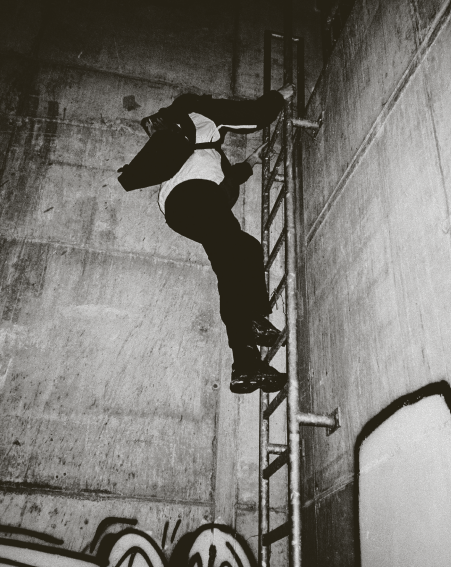Let’s talk about violence in protests – and violence in society
‘Anyone who thinks that violence and property damage are the same thing should try torturing a door.’
Does this quote from Thomas Ebermann sound crude? Or logical? Or both? The discussion behind it certainly isn’t. Because whenever left-wing protests cross the boundaries of what is permissible – or even just of what is acceptable – there is always a huge outcry: ‘Rioters!’, ‘Anarchists!’, ‘Terrorists!’, ‘Pointless!’.
This way, even young people who glue themselves to the streets to protest for more climate-friendly policies and better living conditions are dismissed as malicious violent criminals. However, the violence of those who drive their cars over the hands of demonstrators, drag them across the street by their hair or punch them bluntly in the face is hardly perceived as such.
Equally unquestioned is often the violence of beating cops or the violence with which migrants are driven to their deaths every day at the EU’s external borders. The outrage over non-peaceful left-wing protests gives the impression that there was once a peaceful protest culture through which problems could be resolved amicably. And that we live in what is essentially a peaceful system. According to this view, it is always ‘the others’ who are violent. All of this is nonsense and hypocrisy.
‘We didn’t start the fire’
Nothing in our society is peaceful. On the contrary, we live in a structurally violent system, even if this is widely ignored. Anyone who ‘doesn’t perform’ is considered a problem. Competition between everyone seems completely normal. Meanwhile, people who don’t have a German passport are not only expected to perform, but to perform at the highest level and submit to authority. Without an EU passport and money, people are not really allowed to be here anyway – our society prefers to leave them to the torture chambers of Libya, the Turkish military or the floods of the Mediterranean. Meanwhile, climate change is swallowing up entire regions with water or desert and displacing millions of people, while coal-fired power plants continue to operate here. Every day, new cases of violence and racism by the police come to light. Peace, love, harmony.
So violence doesn’t just fall from the sky when protest crosses some line.
Violence comes for free with the subscription to nationhood and capitalism. And then German interior ministers demand ‘non-violent protest’ against the injustices of the world? That’s not peace-loving. That’s outrageous.
Is that already militancy?
Almost every protest that has achieved positive change in established structures has had to go beyond the limits of laws and peaceful discussion. We can look back to the barricades of the French Revolution and even further back, but there are also numerous examples from the more recent past: When US civil rights activist Rosa Parks refused to accept the ban on black people sitting on buses in 1955, it was a breach of the law and a scandal – and the beginning of the end for many racist laws. The first pride was a riot, in 1969, when queer people in Stonewall, USA, joined forces and fought back against discriminatory police violence. And even Europe’s largest Nazi march, which took place in Dresden for years until 2013, was not stopped by friendly persuasion. Instead, it was the combination of colourful rallies, creative actions by schoolchildren and burning rubbish bins that made the demonstration by thousands of Nazis impossible. But what exactly is militant?
Militancy actually just means decisive action and civil disobedience, with or without physical violence, depending on how the term is used. Some people even describe passport forgery as militant. One thing is certain: Unlike hooliganism, militancy is driven by political goals, not a love of violence.
Who are you to judge?!
‘Take to the streets, you have nothing to lose!’ That doesn’t apply to everyone. Who protests, where, for what and against whom makes a huge difference. Whether as a single mother, call centre employee, asparagus picker or in a deportation prison – the possibilities for effective protest vary.
People are not equally affected by structural violence, nor do they have the same opportunities to defend themselves against it. Those who suffer most from precarious living conditions are often the least able to protest against it and even less able to decide on the most appropriate form of protest. Some cannot afford a roof over their heads or food if they do not go to work tomorrow. Calling for a strike is of little use in such cases.
‘Violence is not a solution, nor should it be’
In response to all this, some activists decide to take militant action, such as spraying paint on a Nazi pub or setting fire to rubbish bins on the route of a fascist demonstration. They hope that without a Nazi meeting place and without a Nazi march, the safety of people in the area will increase. Sometimes militancy is also used to send a symbolic message – for example, by splattering paint on the facades of employment offices, occupying a lignite excavator or blocking the ‘red zone’ of a G20 summit. As different as these examples may be, they are all transgressions, they are all illegal – they are all militancy.
Functional militancy is usually justified by its direct effect: greater security through fewer Nazi structures. Symbolic militancy, on the other hand, is often justified by the argument that conditions are so entrenched and structural violence so oppressive that protest against it must take place ‘outside’ the existing value system. This system does not deserve constructive criticism, but destructive rejection. A few rappers from Berlin once described it this way: ‘Violence is not a solution, nor should it be.’
Of course, there is a lot of discussion about all this. But there is one thing that most leftists agree on: fundamentally, our goal is not violence, but its abolition – but that requires a different society. In this sense, the call of autonomous groups for a militant demonstration on 1 May was: ‘For an end to violence.’
Machos lol
However, these forms of action and debates also lead to a ritualisation and aestheticisation of militancy. This also involves self-dramatisation and the acting out of violent fantasies: Then pyrotechnics are set off just for style or to boost one’s own status, even if other people in the demonstration block are put in danger by collective punishment or escalating police violence. Clothes with slogans such as ‘Nazi Hunter’ strike the same note, focusing solely on ‘big balls’. That doesn’t make anything better, it doesn’t even scare Nazis – it’s just annoying macho behaviour.
Violence, scandal, protest
How you protest is up to you anyway. But you should be careful not to let yourself be pushed into actions that are too much for you or don’t fit your goals. At the same time, it is worth understanding the anger or hopeless situation of others: Not everyone can choose the best form of protest for their cause – and this can result in peaceful or violent protest in a wide variety of forms. But above all: Violence does not begin when pyrotechnics are set off or paving stones are thrown. And certainly not when streets are blocked. Violence begins when profit is more important than people and people are starving in front of full shop windows. When it is quite natural that it is not about solidarity, but about competition. When people are left to their fate at the EU’s external borders and in the climate catastrophe so that we can continue to drive diesel cars undisturbed. When fascists gain power in parliaments and take all this violence much further.
This violence of normality is the real scandal. And it needs to be countered with diverse protest. Inspiration is everywhere. Just do it.
For further reading:
Straßen aus Zucker #13: HamburgHamburgYeah, Krawall & Remmidemmi. Argumentationshilfen zu ein paar gewaltigen Protesten. 2018.
Ein Gruß aus der Zukunft. Mitteilung des …ums Ganze!-Bündnis zum Verlauf der G20-Proteste in Hamburg.



